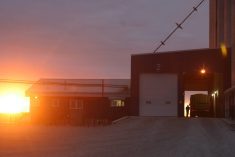BALGONIE, Sask. Ñ You may have seen the Strudwick dairy farm and not even known it.
It has been featured in several dairy commercials and on the children’s television show Sesame Street. (Yes, that Holstein cow that watches its milk travel from farm to processing plant is from Saskatchewan.)
When international delegations visit the province, Harley and Jennifer Strudwick are often called upon to host them.
They say location has everything to do with their high profile.
Prairie Diamond Farm is situated along the Trans-Canada Highway just east of Balgonie, about 30 kilometres from Regina. The silos distinguish it as a dairy and attract attention.
Read Also

Producer profits remain under significant pressure
Manitoba farmers are facing down a double hit of high input costs, like fertilizer, and low grain prices as they harvest their next crop.
Jennifer said they often have unexpected visitors, ranging from curious travellers to retired dairy farmers who need their “fix.”
Last year they found their hired help that way; a couple from Quebec simply drove into the yard and stayed to work.
That the farm is always clean and ready to receive guests is a testament to the family’s hard work and attitude. They are conscious that they are the face of the industry for anyone who drives by or stops in.
Harley and Jennifer are the third generation on the farm started by his grandfather in 1951. The family then milked about 30 cows.
In 1969, Harley’s father, Dale, and uncle joined the operation. In time, they expanded to 100 cows in a free-stall barn.
Harley came aboard in 1982. When he and Jennifer, who grew up on a dairy near Estevan, Sask., married 10 years later, they joined his parents in the business. His grandfather retired and his uncle had turned to grain farming.
“All four of us, this is all we do,” Harley said.
The Strudwicks milk 55 cows on average in a tie-stall barn built in 2000. Jennifer, an architectural engineering technologist by training, designed the barn for about 70 cows.
“That facility was worn out and too hard on the cows,” said Jennifer.
“We had to get new or get out,” added Harley.
Production has increased so much since they moved their cows into the new barn that they don’t need to milk as many to fill their existing quota.
“Rather than go further in debt and buy more quota, we decided to milk less cows,” Harley said.
The idea goes against the current bigger-is-better way of thinking, he said. The average herd size in Saskatchewan is now about 100.
The Strudwicks’ theory that comfortable cows would produce more milk was correct.
“In 2003 we were the highest producing herd in the province, and fourth in Western Canada,” he said.
Annual production averages more than 12,000 kilograms of milk. They milk at 5 a.m. and 4:15 p.m., a schedule designed to fit their lifestyle.
Dale helps with feeding and the fieldwork on the 700 acres they use to grow feed. One quarter of that is irrigated from the town of Balgonie lagoon, an arrangement the family has had for 27 years.
Harley’s mother, Arlyce, does the farm books and feeds calves.
They also have a part-time employee. This summer, two young Quebecers are coming to work on the farm and learn English.
The Strudwicks are involved in their industry at other levels. Dale is a national director of Holstein Canada and is a past president of Canadian Western Agribition. Jennifer is involved with 4-H and the Agribition dairy show.
This week they’ve taken some of their cows to the Western Canadian Livestock Expo in Saskatoon. The national Holstein convention is also under way.
“It’s important to voice your opinion, to take the time to be involved,” Jennifer said, especially with the hot-button issues of trade and BSE.
Harley said their farm income has dropped between 10 and 15 percent due to BSE, mostly through lost sales of cull cows and breeding stock.
They have sold embryos domestically and are starting to see some international potential for their genetics, said Jennifer.
Although the couple made a choice to stay on the dairy when they built the new barn, they say they aren’t married to the farm and can see the day when the lifestyle won’t be so attractive.
It isn’t for everybody, Jennifer observed.

















